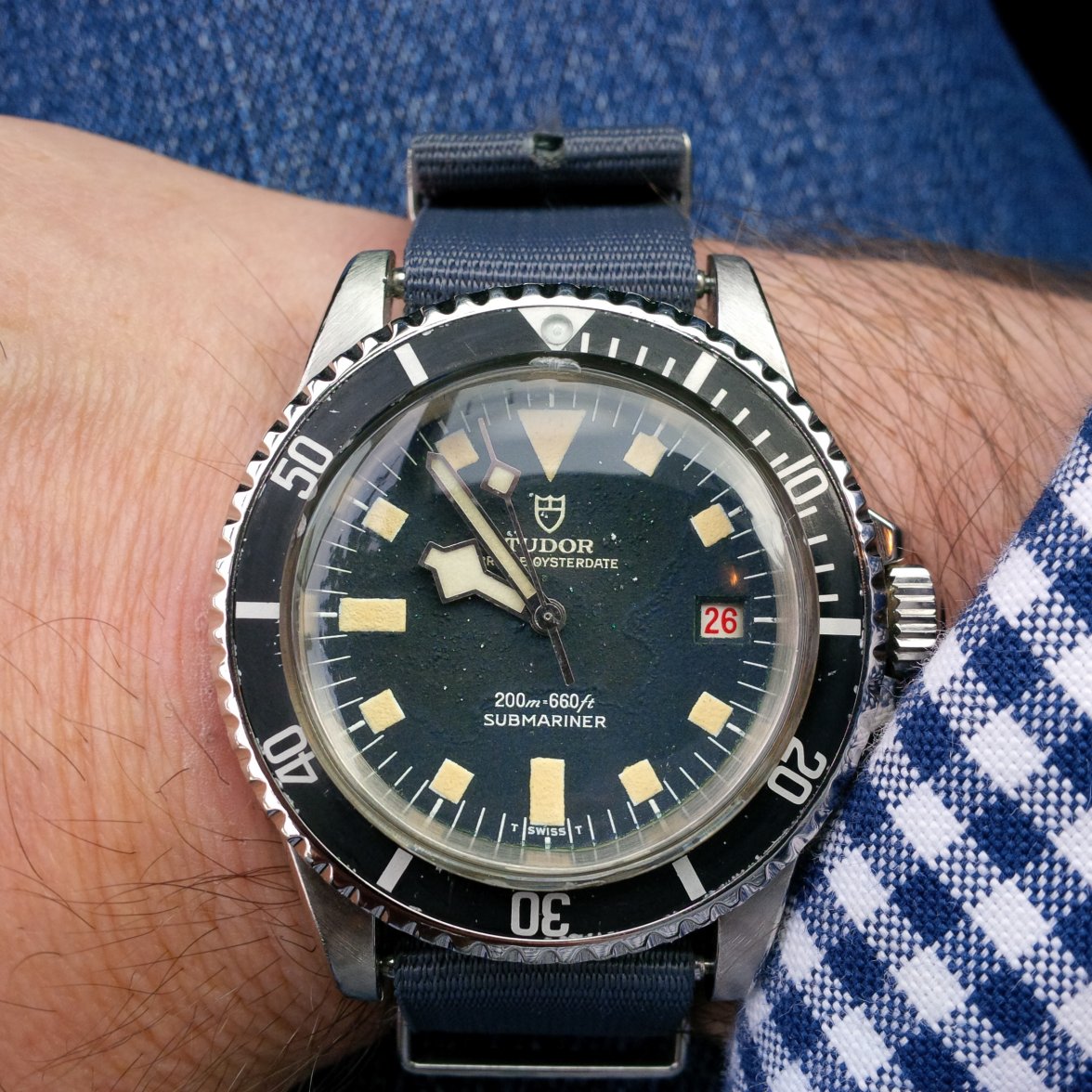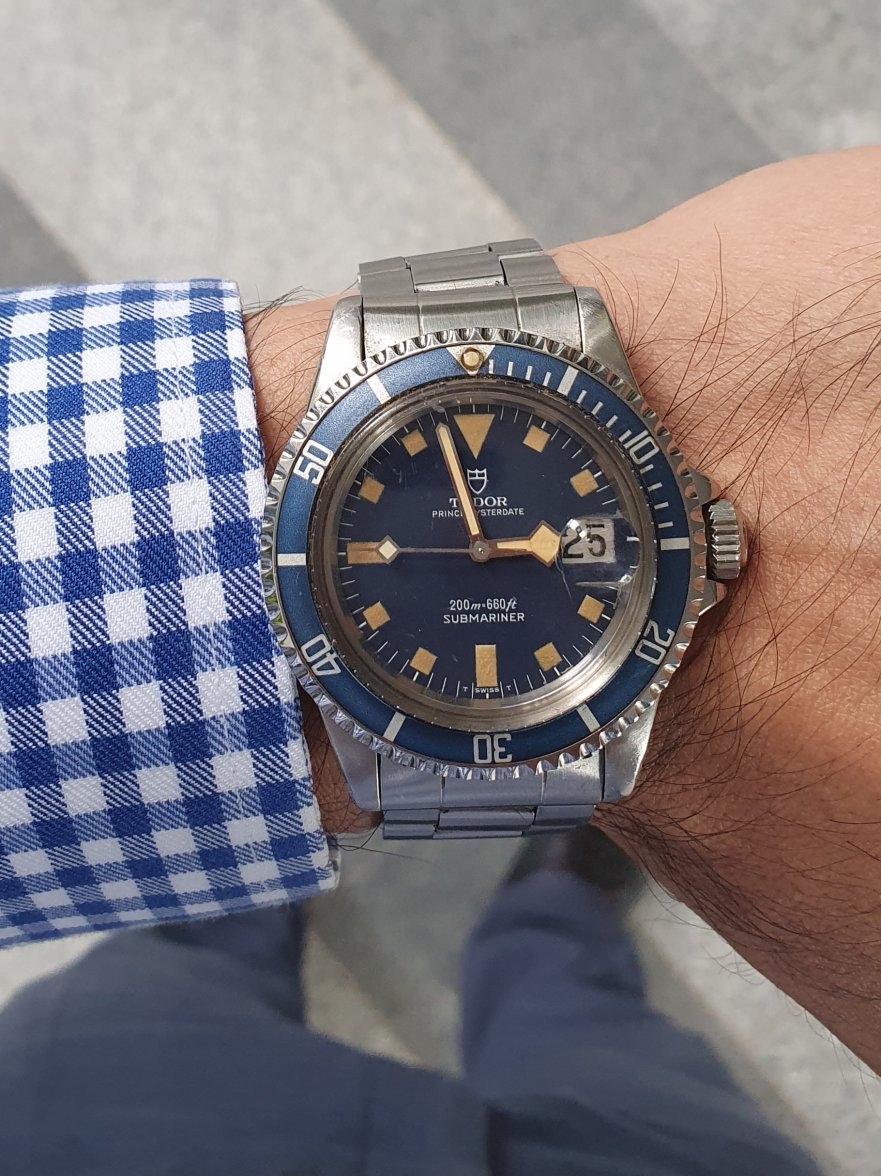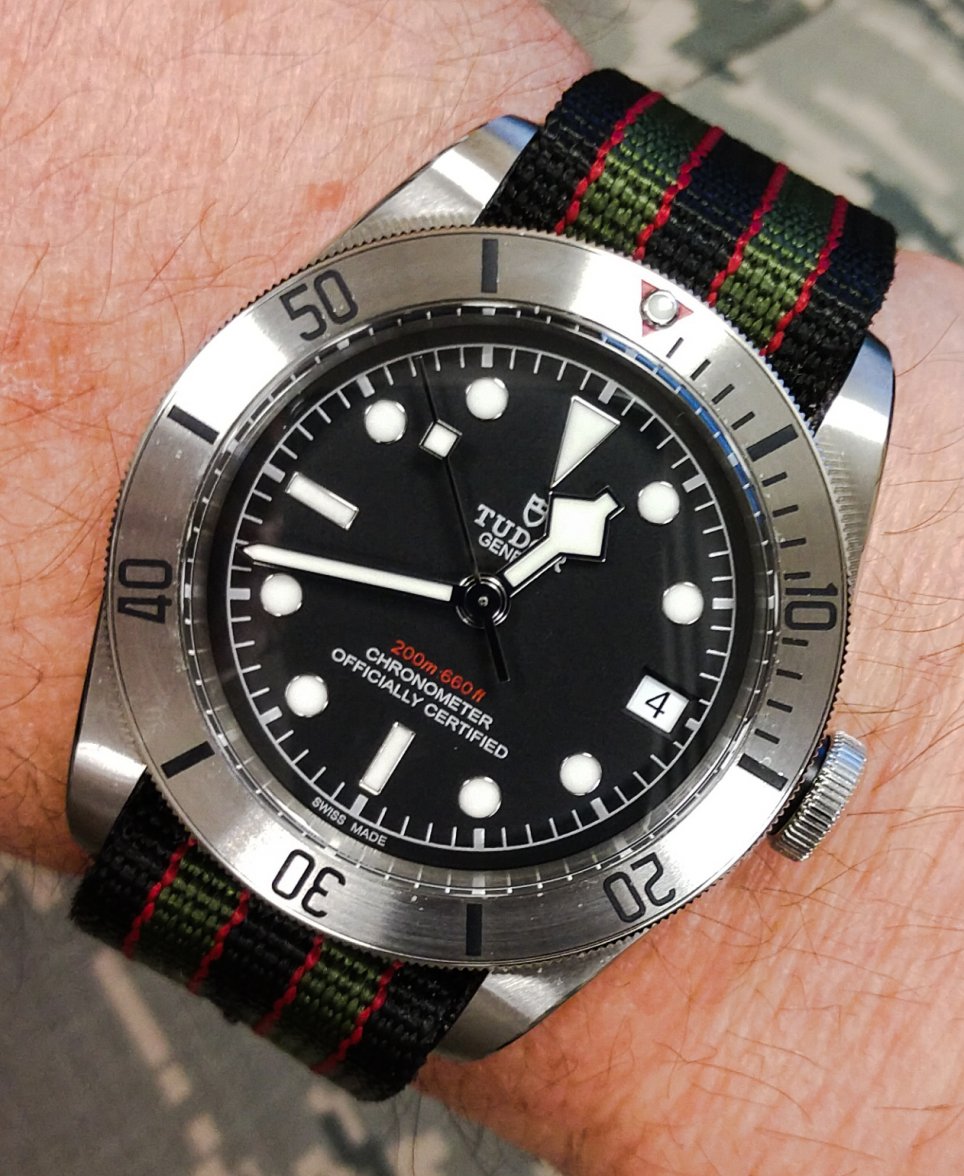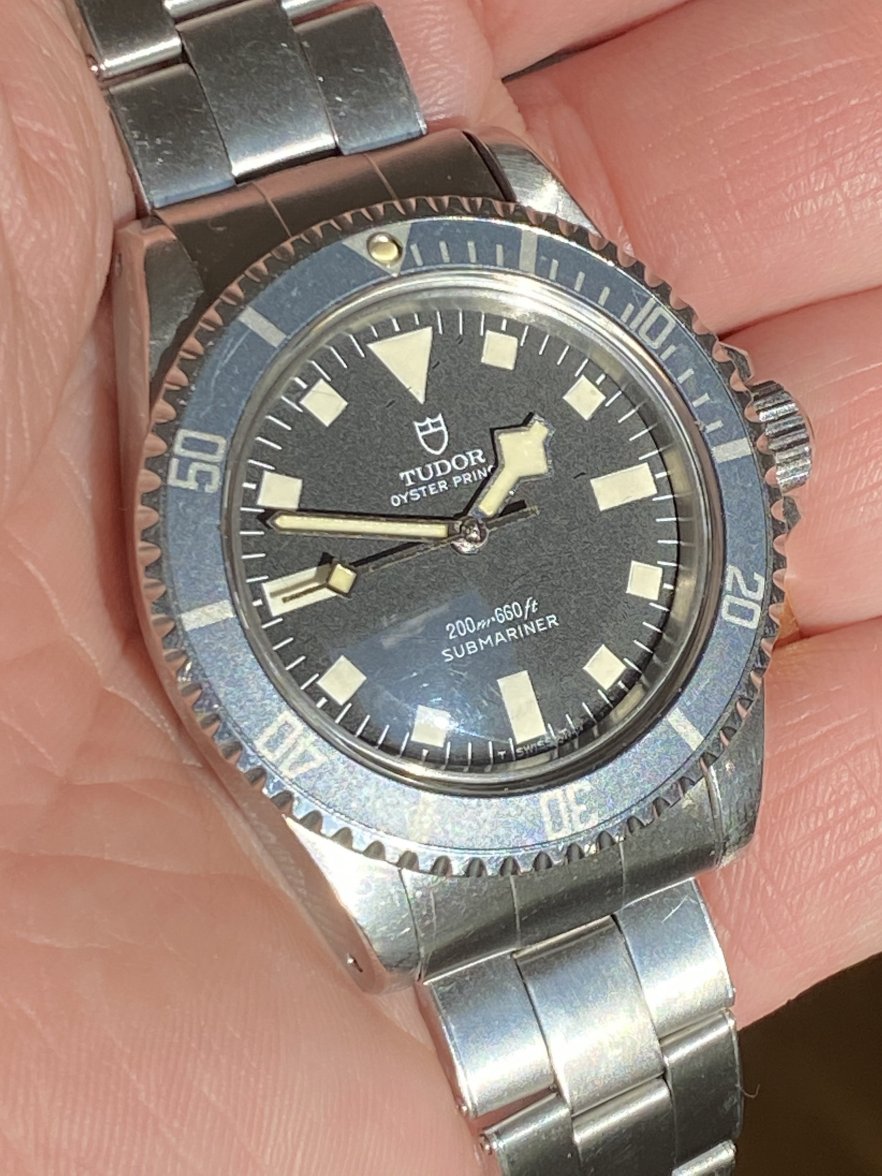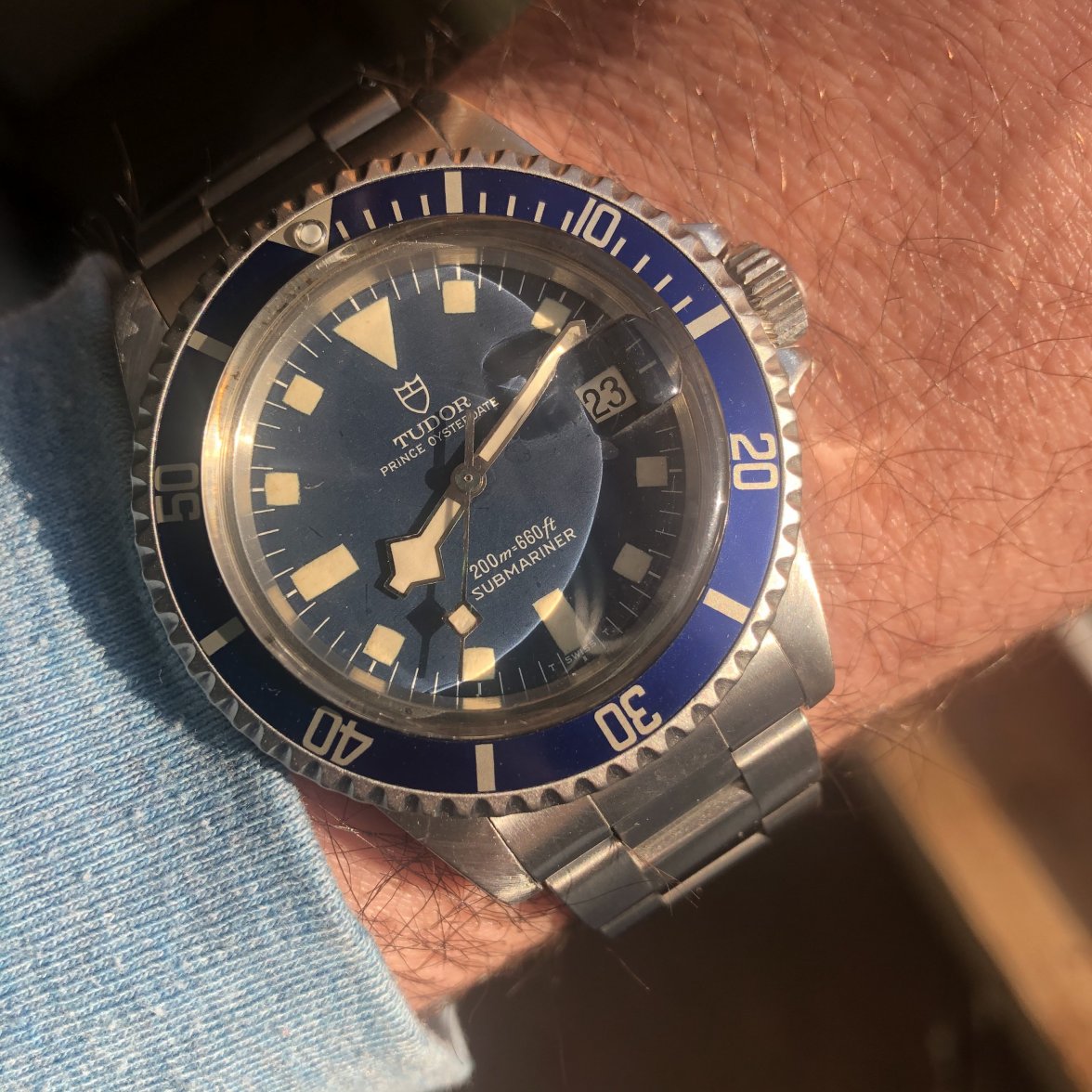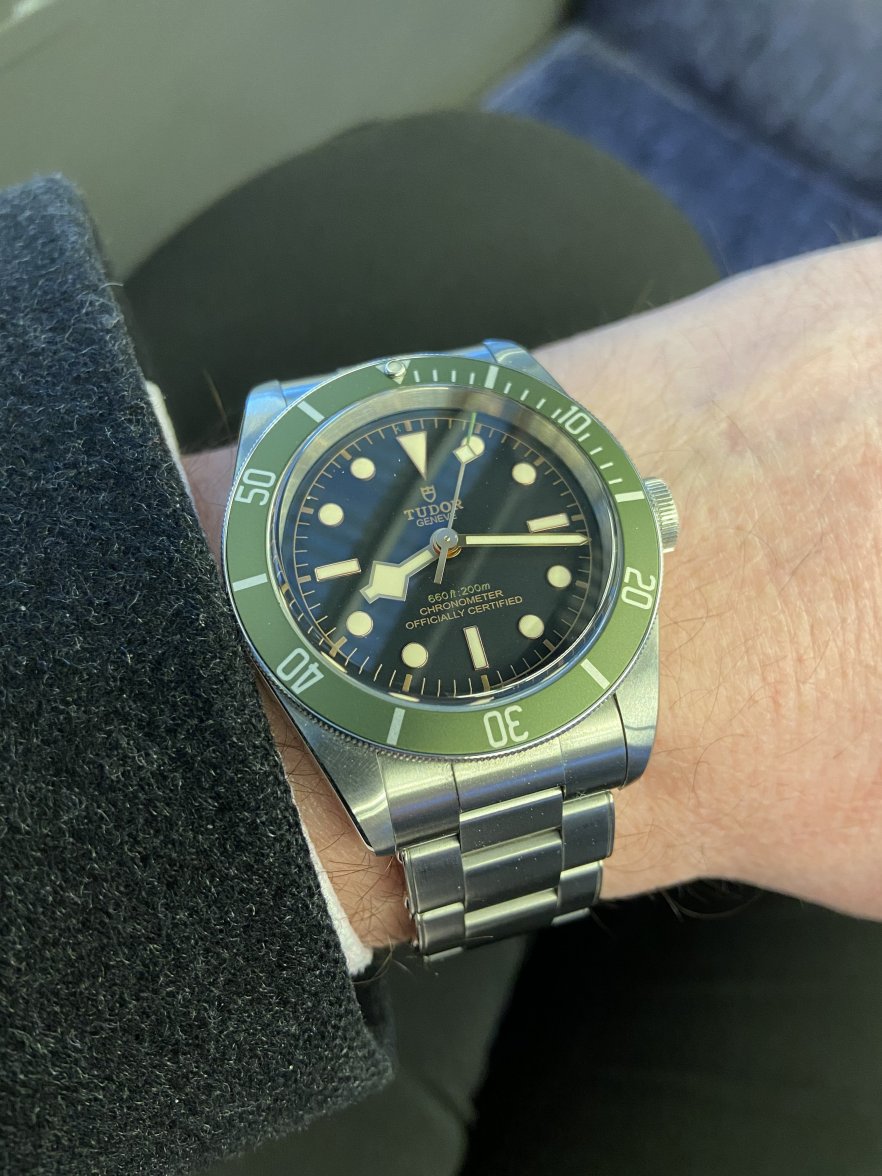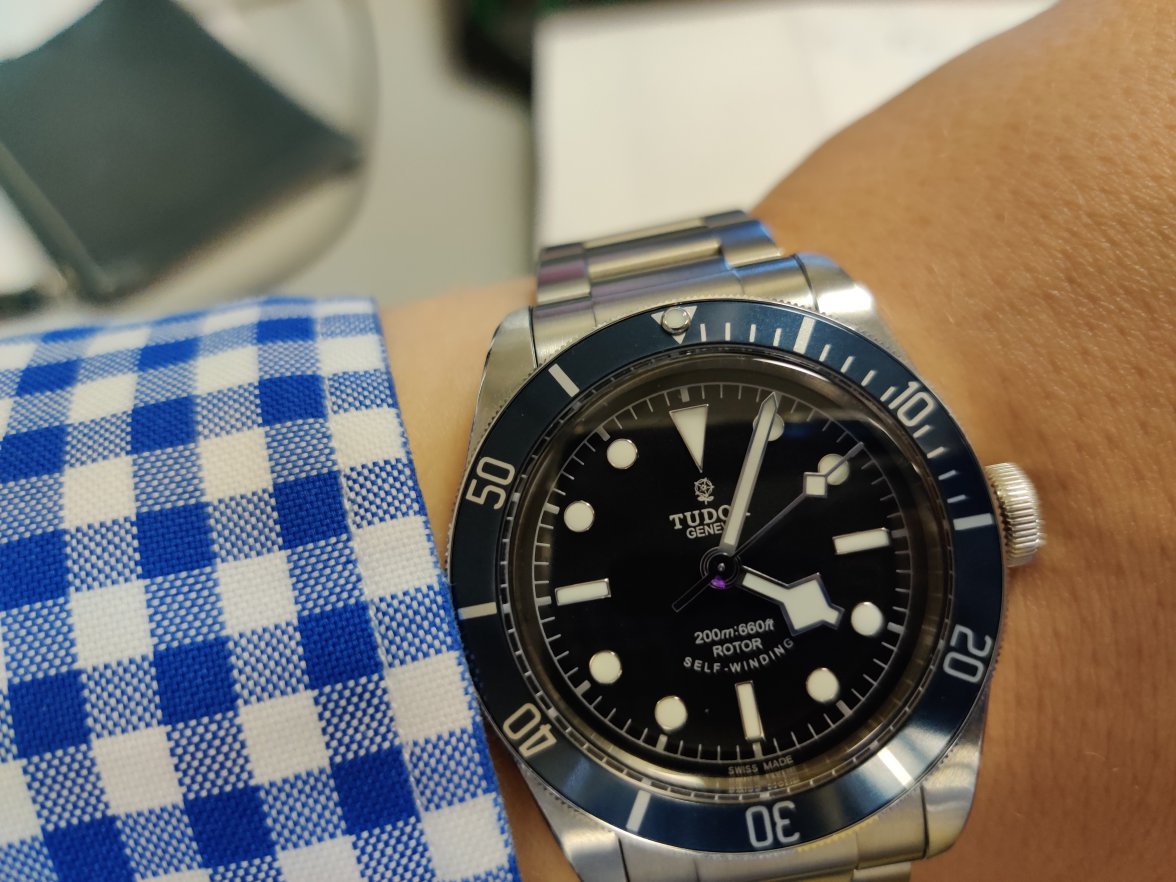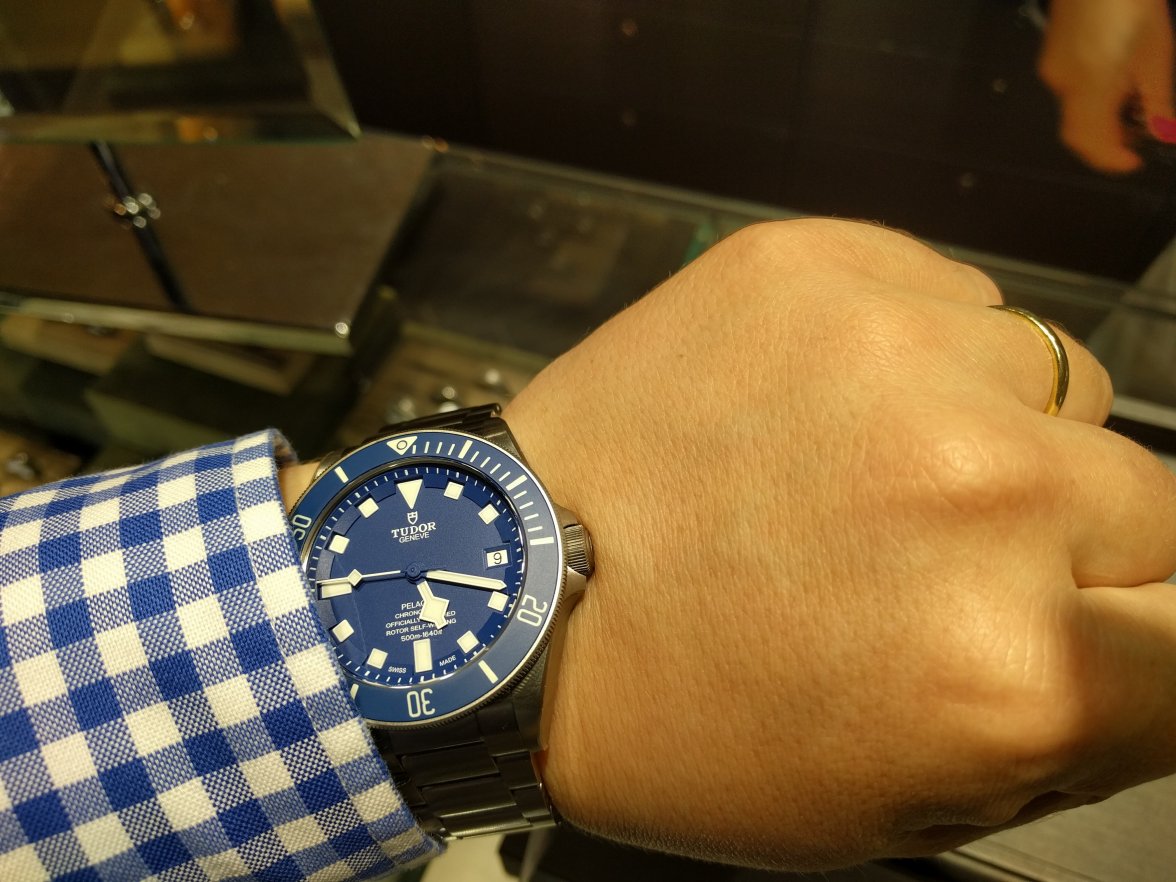Tudor Snowflakes - let’s see them?
- Posts
- 81
- Likes
- 96
greenecollector
·My 7021 issued by the USN...story below for anyone who wants a long read!
...
I first became acquainted with ex-Royal Navy diver Bill McGovern in December 2011 when we exchanged emails regarding the Omega Seamaster 300, a watch I was researching at that time.
I asked Bill is he had been issued any watches during his time in the Navy?
He wrote:
From: Bill McGovern
To: John
Sent: Mon, Dec 5, 2011 01:32 PM
Subject: Re: Royal Navy Diving Watches.
John,
I was issued with the Rolex from 69 to 84, I saw the Omega's but preferred the other, I was young, big watch, you get the idea.
I also had a Tudor, I was issued this in the USA whilst Experimental Diving, I still have it, they let me keep it, most divers LOST at least 2 watches (???) during service ha ha, they were good watches and quite reliable, hope this helps you,
yours aye,
Bill
............................................................
It was at this point I set off down the long road to try to purchase the Tudor.
Finally, after 5 years of on & off emails, text messages, poor photos, vague information, ill health, and a burglary I finally found myself in May 2016, boarding a plane at London Gatwick headed for Glasgow and a visit to finally collect the watch and meet Bill.
Sadly he is rather unwell due to breathing difficulties, the result of a wrongly prescribed medication, however the four hours I spent with Bill were enough to reveal the life of a Royal Navy diver during the 1970's.
He told me of the experiments that altered the body both temporarily (nitrogen narcosis) "they had to give you the bends to see what they could get away with" he said & permanently (increased lung capacity from breath holding) and tales of raising hell all over the world & a dog sent into a in a swimming pool, much to the Officer's delight!
This is his story....
Bill McGovern joined the Royal Navy in 1968, as a Seaman and immediately underwent training to become a diver.
He was the first to be qualified directly as a diver at HMS Vernon, Portsmouth.
Time with the Fleet Clearance Diving Team followed, both home and abroad on various diving & mine clearance operations.
Bill was saw service on board the minesweepers HMS Wilton, HMS Brinton & HMS Gavinton, and also on HMS Bulwark, an aircraft carrier.
The Suez Canal kept the Fleet Clearance Diving Team busy as they worked to clear ordnance and other military debris following the Arab-Israeli 6 Day War.
Bill was photographed in the news, loading HMS Abdiel.
The final tally of items removed included 209 tons of TNT bombs of various sizes, about 800 anti-tank and anti-personnel mines, 6,000 rounds of ammunition and 70 various missiles.
With 5 years of diving experience and at the age of 25 Bill returned to Portsmouth and the Admiralty Experimental Dive Unit.
Bill recounted how the divers were the envy of the Navy officers in Portsmouth as they were so well paid.
As they would earn an extra £80 for dives over 100ft they made sure they 'had' to do one a week!
"We were flash bastards" Bill said, "I had a new Rover and one of the other divers a pink Mercedes, aye, we really got up the Officer's noses"
Work with the Royal Navy Physiological Laboratory on new decompression tables followed. The US Navy were working on similar tables concurrently and therefore it was decided to engage in an exchange program.
This culminated in 1975 when a team of 14 British divers (Bill being one of them) was sent to the USA to work with the US Navy Experimental Dive Unit in Panama City, Florida.
They were to carry out sea trials of the new tables using the Mark 1 Deep Dive System, installed on the diving barge YDT-16, from which a team of divers had already set an open sea World Record depth of 1148ft.
It was on arrival in the Gulf of Mexico that Bill noticed his issued Rolex Submariner was steamed up.
He informed Command and Bo Burwell who was there removed his watch from his wrist and gave it to Bill.
Bill handed his Rolex over to the US Navy for repair.
This was quite an exciting discovery as I knew the name Bo Burwell since he was one of the US divers who had set the World Record depth.
I contacted Bo Burwell in the hope of finding out more, and if this watch had been given by him.
This is what he wrote:
From: Bo Burwell
Sent: Friday, 27 May 2016 21:14
To: John
Subject: Re: MK1 DDS dives with NEDU
John,
I remember Bill McGovern and his recollections are correct. The British Sat Team were with us during that summer period to do at-sea testing of the diving tables developed at their lab. The name escapes me of that lab. I was one of the Dive Watch Supervisors during the Dive Trials of their tables. That was a most productive time between our countries, the Dive Teams, and individuals involved. One of those gents passed away just after returning home and our Mark 1 DDS took up a collection to assist his widow.
I made both of the U.S. Navy's two deepest dives, in 1975 from the Mark 1 DDS to 1148 feet and in 1979 at NEDU to 1800 feet.
The Mark 1 DDS 1975 dive team included British Clearance Diver Victor Humphrey BEM - he also parachuted into the waters to clear the cruise ship QE2 from (possible explosives), I cannot remember the year. Victor was the bell operator for the world record dive, myself and William Rhodes were the divers. Our dive was in May 1975 and lasted 17 days.
Rolex was the dive watch of choice In those days by Navy divers and others throughout the world.
My Rolex exploded on the return to the surface from the 1800ft dive in 1979.
Bo Burwell
............................................................
This was really great news and more than I could have hoped for.
Following the American success the Royal Navy team were able to set a new British open-sea record of 990ft.
Bill participated in the build up dives to 600ft.
I asked what it was like being that deep, "it's a long way up son" he said.
At the conclusion of the program Bill tried to return the watch but was told he could keep it...along with the sunglasses and leather flying jacket he'd been issued "we looked like fυcking Top Gun" he said.
He was also given two wall plaques in commemoration of his time with the NEDU which now hang proudly in his kitchen.
The dives made the news in Panama, featuring in the press:
British Diving
Squad Complete Record Dive
A British saturation diving team, utilising the U.S. Navy's Mark 1 Deep Dive System Tuesday successfully completed a dive to a depth of 990 feet, the deepest open-sea dive recorded by a British diving team.
Operating as part of a four-man team with two U.S. divers Chief Petty Officer Chris Ballinger and Leading Diver Anthony Pritchard swam out of the Personnel Transfer Capsule to reach the record depth.
The dive was made in the Gulf of Mexico 7.5 miles south of Panama during trials by the British on saturation dive tables that have been perfected by United States and United Kingdom personnel at the Naval Physiological Laboratory in Portsmouth, England.
The U.K. and U.S. diving teams have been working together and conducting joint operations with the Mk 1 Deep Dive Systems since June.
The trials were a continuation of a series of saturation dives that resulted in a world record of 1148 feet set on June 18 by three U.S. and one British diver.
During the familiarisation phase with the Mk 1 System, the UK divers, under officer-in-charge LCDR William Norton, as a result of good training in their homeland, acquainted themselves in an amazingly short period with the system, its equipment and procedures.
The men from two nations have worked harmoniously together, considering the complexity of the deep dive systems said Lt. Bob Lusty, officer in charge of the U.S. Navy Mark 1 Deep Dive System.
Communication between the men has been excellent, Lt. Commander Norton added "The key to the fine relationship and communication between the two units has been the excellent rapport among the divers themselves," he and Lusty emphasised.
With LCDR Norton in charge, the Royal Navy diving team here includes R.R. Wells U.S. Navy Exchange officer-; Fleet Chief Petty Officer (DV) D.J. Clark. Chief Petty Officer (DV) C.J. Ballinger-, Petty Officer (DV) R. Allen, Leading Diver A.R. Pritchard, Leading Diver T.N.'O'Hanlon, Leading Diver CM- Coldwell, Leading Diver P. Miller, Leading Diver A. Pauly. Leader Diver J.P. Cox, Able Seaman (DV) N.B. White; Able Seaman (DV) R.A.P. Baker; Able Seaman (DV) M.J. Mead; Leading Seaman (DV) W.B. McGovern, and Petty Officer Medical Assistant C.L. Borg.
Comprising the U.S. Navy MK 1 Deep Dive System diving team, with Lt. Lusty in charge are: EN (DV) Marion L. Alexander; EN2 (DV) Joseph L. Benoit; HTC (MDV) Richard O. Brady; MMCS (DV) Lowell E. Burwell; HTl (DV) Bradoc A. Cole; EMI (DV) Hubert L. English; MNl (DV) John P. Fair, .EN2 (DV) Bruce D. Harkins; MRC (DV) Charles A. Holton; EM2 (DV) John P. Johnston; MMl (DV) James F. Leiand; BMC (DV) Daniel B. McNeil; BM2 (DV) Terry L. Miles; QM2 (DV) Vernon S. Miller; EMC (DV) Jon B. Nelson; BMC (DV) Lee H. Nielsen; HTC (DV) Johnny D. Pitscheneder; ETC (DV) William R. Rhodes; HTC (DV) Robert G. Watkins; MMC(DV) Charles D. Wetzel; MMl (DV) Jerry L. Winemiller; GMGl (DV) Dan K. Vanderford; CW02 Donald R, Roljerts, and CPO Victor Humphrey.
(excerpt from the Panama City News)
............................................................
6 months after his return to Portsmouth his Milsub followed him home, freshly serviced and looking brand new, much to his surprise! - "like a prat" Bill said "I handed it back in to stores"
Bill continued to wear the Tudor, on a NATO strap.
He used it for dives in West Africa, North Africa, the West Indies, Fort Lauderdale, Miami, Venezuela, Brazil, France, Germany, Norway, Denmark, Malta, Holland, India and many more.
Then a posting to HMS Faslane saw him working in hyperbaric medicine manning the decompression chamber as well as training Submariners in escape practises, free diving to 100ft.
1984 saw him retire from the Royal Navy.
Two years in the North Sea followed with Subsea before he retired from diving and returned home to just outside Glasgow.
Upon getting the watch it was missing the crown, lost whilst chopping logs and the bezel was bent and detached.
The watch was fitted with a T-39 tropic with a hefty dent in it.
A twin-lock crown was sourced and the watch was turned over to Mike Wood at the The Old Watch Shop for overhaul and sympathetic cleaning in June 2016 and fitted to a NATO strap as it had always been worn.
The case back is marked IV.70 and has one service mark from April 1975, so it's last service would have been immediately prior to the DDS dives.
I'm pleased to have this watch, used on dives which broke World Records and pushed forward the boundaries of man underwater in my collection and even more so to have met Bill and to be able to tell his story.
Sadly Bill passed away in November 2016.
His name is recorded at the Royal Navy Clearance Diver memorial garden, where all Royal Navy divers who have past are remembered at the Defence Diving School at Horsea Island, Portsmouth.
...
I first became acquainted with ex-Royal Navy diver Bill McGovern in December 2011 when we exchanged emails regarding the Omega Seamaster 300, a watch I was researching at that time.
I asked Bill is he had been issued any watches during his time in the Navy?
He wrote:
From: Bill McGovern
To: John
Sent: Mon, Dec 5, 2011 01:32 PM
Subject: Re: Royal Navy Diving Watches.
John,
I was issued with the Rolex from 69 to 84, I saw the Omega's but preferred the other, I was young, big watch, you get the idea.
I also had a Tudor, I was issued this in the USA whilst Experimental Diving, I still have it, they let me keep it, most divers LOST at least 2 watches (???) during service ha ha, they were good watches and quite reliable, hope this helps you,
yours aye,
Bill
............................................................
It was at this point I set off down the long road to try to purchase the Tudor.
Finally, after 5 years of on & off emails, text messages, poor photos, vague information, ill health, and a burglary I finally found myself in May 2016, boarding a plane at London Gatwick headed for Glasgow and a visit to finally collect the watch and meet Bill.
Sadly he is rather unwell due to breathing difficulties, the result of a wrongly prescribed medication, however the four hours I spent with Bill were enough to reveal the life of a Royal Navy diver during the 1970's.
He told me of the experiments that altered the body both temporarily (nitrogen narcosis) "they had to give you the bends to see what they could get away with" he said & permanently (increased lung capacity from breath holding) and tales of raising hell all over the world & a dog sent into a in a swimming pool, much to the Officer's delight!
This is his story....
Bill McGovern joined the Royal Navy in 1968, as a Seaman and immediately underwent training to become a diver.
He was the first to be qualified directly as a diver at HMS Vernon, Portsmouth.
Time with the Fleet Clearance Diving Team followed, both home and abroad on various diving & mine clearance operations.
Bill was saw service on board the minesweepers HMS Wilton, HMS Brinton & HMS Gavinton, and also on HMS Bulwark, an aircraft carrier.
The Suez Canal kept the Fleet Clearance Diving Team busy as they worked to clear ordnance and other military debris following the Arab-Israeli 6 Day War.
Bill was photographed in the news, loading HMS Abdiel.
The final tally of items removed included 209 tons of TNT bombs of various sizes, about 800 anti-tank and anti-personnel mines, 6,000 rounds of ammunition and 70 various missiles.
With 5 years of diving experience and at the age of 25 Bill returned to Portsmouth and the Admiralty Experimental Dive Unit.
Bill recounted how the divers were the envy of the Navy officers in Portsmouth as they were so well paid.
As they would earn an extra £80 for dives over 100ft they made sure they 'had' to do one a week!
"We were flash bastards" Bill said, "I had a new Rover and one of the other divers a pink Mercedes, aye, we really got up the Officer's noses"
Work with the Royal Navy Physiological Laboratory on new decompression tables followed. The US Navy were working on similar tables concurrently and therefore it was decided to engage in an exchange program.
This culminated in 1975 when a team of 14 British divers (Bill being one of them) was sent to the USA to work with the US Navy Experimental Dive Unit in Panama City, Florida.
They were to carry out sea trials of the new tables using the Mark 1 Deep Dive System, installed on the diving barge YDT-16, from which a team of divers had already set an open sea World Record depth of 1148ft.
It was on arrival in the Gulf of Mexico that Bill noticed his issued Rolex Submariner was steamed up.
He informed Command and Bo Burwell who was there removed his watch from his wrist and gave it to Bill.
Bill handed his Rolex over to the US Navy for repair.
This was quite an exciting discovery as I knew the name Bo Burwell since he was one of the US divers who had set the World Record depth.
I contacted Bo Burwell in the hope of finding out more, and if this watch had been given by him.
This is what he wrote:
From: Bo Burwell
Sent: Friday, 27 May 2016 21:14
To: John
Subject: Re: MK1 DDS dives with NEDU
John,
I remember Bill McGovern and his recollections are correct. The British Sat Team were with us during that summer period to do at-sea testing of the diving tables developed at their lab. The name escapes me of that lab. I was one of the Dive Watch Supervisors during the Dive Trials of their tables. That was a most productive time between our countries, the Dive Teams, and individuals involved. One of those gents passed away just after returning home and our Mark 1 DDS took up a collection to assist his widow.
I made both of the U.S. Navy's two deepest dives, in 1975 from the Mark 1 DDS to 1148 feet and in 1979 at NEDU to 1800 feet.
The Mark 1 DDS 1975 dive team included British Clearance Diver Victor Humphrey BEM - he also parachuted into the waters to clear the cruise ship QE2 from (possible explosives), I cannot remember the year. Victor was the bell operator for the world record dive, myself and William Rhodes were the divers. Our dive was in May 1975 and lasted 17 days.
Rolex was the dive watch of choice In those days by Navy divers and others throughout the world.
My Rolex exploded on the return to the surface from the 1800ft dive in 1979.
Bo Burwell
............................................................
This was really great news and more than I could have hoped for.
Following the American success the Royal Navy team were able to set a new British open-sea record of 990ft.
Bill participated in the build up dives to 600ft.
I asked what it was like being that deep, "it's a long way up son" he said.
At the conclusion of the program Bill tried to return the watch but was told he could keep it...along with the sunglasses and leather flying jacket he'd been issued "we looked like fυcking Top Gun" he said.
He was also given two wall plaques in commemoration of his time with the NEDU which now hang proudly in his kitchen.
The dives made the news in Panama, featuring in the press:
British Diving
Squad Complete Record Dive
A British saturation diving team, utilising the U.S. Navy's Mark 1 Deep Dive System Tuesday successfully completed a dive to a depth of 990 feet, the deepest open-sea dive recorded by a British diving team.
Operating as part of a four-man team with two U.S. divers Chief Petty Officer Chris Ballinger and Leading Diver Anthony Pritchard swam out of the Personnel Transfer Capsule to reach the record depth.
The dive was made in the Gulf of Mexico 7.5 miles south of Panama during trials by the British on saturation dive tables that have been perfected by United States and United Kingdom personnel at the Naval Physiological Laboratory in Portsmouth, England.
The U.K. and U.S. diving teams have been working together and conducting joint operations with the Mk 1 Deep Dive Systems since June.
The trials were a continuation of a series of saturation dives that resulted in a world record of 1148 feet set on June 18 by three U.S. and one British diver.
During the familiarisation phase with the Mk 1 System, the UK divers, under officer-in-charge LCDR William Norton, as a result of good training in their homeland, acquainted themselves in an amazingly short period with the system, its equipment and procedures.
The men from two nations have worked harmoniously together, considering the complexity of the deep dive systems said Lt. Bob Lusty, officer in charge of the U.S. Navy Mark 1 Deep Dive System.
Communication between the men has been excellent, Lt. Commander Norton added "The key to the fine relationship and communication between the two units has been the excellent rapport among the divers themselves," he and Lusty emphasised.
With LCDR Norton in charge, the Royal Navy diving team here includes R.R. Wells U.S. Navy Exchange officer-; Fleet Chief Petty Officer (DV) D.J. Clark. Chief Petty Officer (DV) C.J. Ballinger-, Petty Officer (DV) R. Allen, Leading Diver A.R. Pritchard, Leading Diver T.N.'O'Hanlon, Leading Diver CM- Coldwell, Leading Diver P. Miller, Leading Diver A. Pauly. Leader Diver J.P. Cox, Able Seaman (DV) N.B. White; Able Seaman (DV) R.A.P. Baker; Able Seaman (DV) M.J. Mead; Leading Seaman (DV) W.B. McGovern, and Petty Officer Medical Assistant C.L. Borg.
Comprising the U.S. Navy MK 1 Deep Dive System diving team, with Lt. Lusty in charge are: EN (DV) Marion L. Alexander; EN2 (DV) Joseph L. Benoit; HTC (MDV) Richard O. Brady; MMCS (DV) Lowell E. Burwell; HTl (DV) Bradoc A. Cole; EMI (DV) Hubert L. English; MNl (DV) John P. Fair, .EN2 (DV) Bruce D. Harkins; MRC (DV) Charles A. Holton; EM2 (DV) John P. Johnston; MMl (DV) James F. Leiand; BMC (DV) Daniel B. McNeil; BM2 (DV) Terry L. Miles; QM2 (DV) Vernon S. Miller; EMC (DV) Jon B. Nelson; BMC (DV) Lee H. Nielsen; HTC (DV) Johnny D. Pitscheneder; ETC (DV) William R. Rhodes; HTC (DV) Robert G. Watkins; MMC(DV) Charles D. Wetzel; MMl (DV) Jerry L. Winemiller; GMGl (DV) Dan K. Vanderford; CW02 Donald R, Roljerts, and CPO Victor Humphrey.
(excerpt from the Panama City News)
............................................................
6 months after his return to Portsmouth his Milsub followed him home, freshly serviced and looking brand new, much to his surprise! - "like a prat" Bill said "I handed it back in to stores"
Bill continued to wear the Tudor, on a NATO strap.
He used it for dives in West Africa, North Africa, the West Indies, Fort Lauderdale, Miami, Venezuela, Brazil, France, Germany, Norway, Denmark, Malta, Holland, India and many more.
Then a posting to HMS Faslane saw him working in hyperbaric medicine manning the decompression chamber as well as training Submariners in escape practises, free diving to 100ft.
1984 saw him retire from the Royal Navy.
Two years in the North Sea followed with Subsea before he retired from diving and returned home to just outside Glasgow.
Upon getting the watch it was missing the crown, lost whilst chopping logs and the bezel was bent and detached.
The watch was fitted with a T-39 tropic with a hefty dent in it.
A twin-lock crown was sourced and the watch was turned over to Mike Wood at the The Old Watch Shop for overhaul and sympathetic cleaning in June 2016 and fitted to a NATO strap as it had always been worn.
The case back is marked IV.70 and has one service mark from April 1975, so it's last service would have been immediately prior to the DDS dives.
I'm pleased to have this watch, used on dives which broke World Records and pushed forward the boundaries of man underwater in my collection and even more so to have met Bill and to be able to tell his story.
Sadly Bill passed away in November 2016.
His name is recorded at the Royal Navy Clearance Diver memorial garden, where all Royal Navy divers who have past are remembered at the Defence Diving School at Horsea Island, Portsmouth.
Uniqez
·Thanks for sharing, this is quite a story!
- Posts
- 19
- Likes
- 10
- Posts
- 19
- Likes
- 10
missourifarmer
·Here's mine... a bit of patina!!
chows99
·jhross98
·67ViP
·Bp1000
·My god some of the watches in this thread are incredible
I only have 2 new ones
I only have 2 new ones
Linesiders
··Stripers, not snook.chows99
·Hoddspur
·nzshadow
·I have nothing to add aside from stating the bloody obvious: Your watches are all utterly breathtaking and I WANT ONE.
You rotters may have initiated an assault on my bank balance. I hope you're happy.
You rotters may have initiated an assault on my bank balance. I hope you're happy.
Linesiders
··Stripers, not snook.I have nothing to add aside from stating the bloody obvious: Your watches are all utterly breathtaking and I WANT ONE.
You rotters may have initiated an assault on my bank balance. I hope you're happy.
Come to the Dark Side. We have Cookies.
Capt Cave Man
·[Snigger] Snowflakes...
Some wonderful watches pictured in this thread, I may have to add one to the wish list at some point just to wind up the next generation in the household. [\Snigger]
Some wonderful watches pictured in this thread, I may have to add one to the wish list at some point just to wind up the next generation in the household. [\Snigger]



